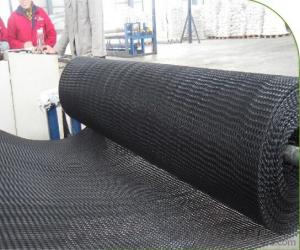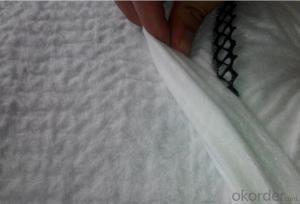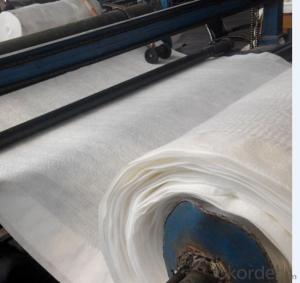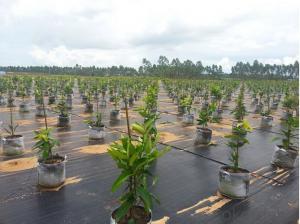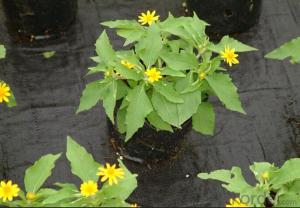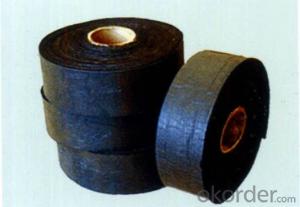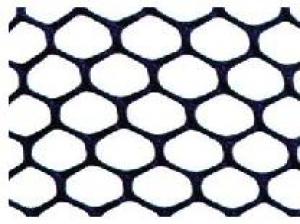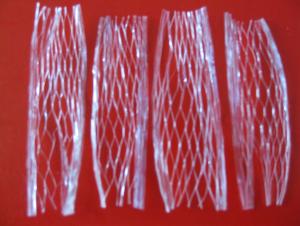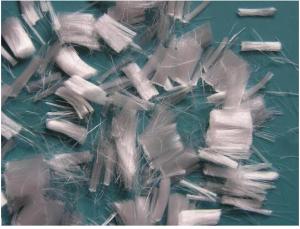Tr-dimension Composite Geonet ;Drainage Geocomposites
- Loading Port:
- Qingdao
- Payment Terms:
- TT OR LC
- Min Order Qty:
- 2000 m²
- Supply Capability:
- 200000 m²/month
OKorder Service Pledge
OKorder Financial Service
You Might Also Like
HDPE Drainage Geocomposite / Composite drainage geonet
Description :
Drainage Geocomposites are engineered to replace costly, conventional open graded aggregate and/or perforated- pipe subsurface drainage systems. The Geocomposite Drainage is created by laminating a filtration geotextile on one or both sides of a Geonet. Geocomposite Drainages have reached acceptance as state-of-the-practice because they provide sufficient in-place drainage and offer reduced material cost, installation time and design complexity over conventional systems.
Application:
1) Landfill drainage;
2) roadbed and road drainage;
3) railway drainage;
4) tunnel drainage,
5) underground structure drainage,
6) the retaining back wall drainage;
7) gardens and sports ground drainage
Features:
1)Excellent drainage function, can bear long time hige press load
2)High tensile and shear strength
3Reduce the rate geotextile embedding into the core of geonet, can protect long time stable water conductivity
4)Tri-dimension composite geonet for drainage can bear more than 2000kpa compression load
5)Its anti-compression capacity is much larger than common geonet for drainage
6) Certificate :ISO14001:2004, ISO9001:2008
Specifications and technical parameters:
Drainage network core | units | Specification | ||||
Unit weight | g/m2 | 750 | 1000 | 1300 | 1600 | |
Thickness | Mm | 5.0 | 6.0 | 7.0 | 7.6 | |
Hydraulic conductivity | m/s | kx10-4 | Kx10-4 | Kx10-4 | Kx10-4 | |
Elongation | % | 50 | 50 | 50 | 50 | |
Tensile strength (core netwaork) | kN/m | 8 | 10 | 12 | 14 | |
Geotextile | g/m2 | Heavier grades of geotextiles can be bonded to geonet on request | ||||
Usages:
In the railway, highway and other transportation infrastructure, drainage system safety and the service life
of the project and its have inseparable relationship, in which the geotextile material is an important part
of drainage system, the drainage effect of 3D composite drainage net is particularly notable. mainly
used for tunnels, municipal engineering, reservoir, revetment in drainage engineering.
FAQ
1. Which payment do you accept?
For you convinience,our payment can be L/C,TT
2. Is free sample available?
We can supply free samples if you need.
3. How about your quality?
We have strict quality control system, we make testing on incoming raw material and finished products. Your third party testing is also welcomed. With high quality, our products are used on government projects at home and abroad. Our product quality is accepted by clients from all over the world.

- Q:What are the advantages of using geotextile fabrics in green roof installations?
- Some advantages of using geotextile fabrics in green roof installations include improved drainage and water retention, increased root protection, enhanced soil stability, and reduced weed growth. Geotextile fabrics also help prevent soil erosion and promote healthier plant growth by providing a barrier against contaminants.
- Q:Can earthwork products be used in slope stabilization for railways?
- Yes, earthwork products can be used in slope stabilization for railways. These products, such as geotextiles, geogrids, and retaining walls, are designed to provide reinforcement, erosion control, and stability to slopes. They can help prevent soil erosion, mitigate landslides, and enhance the overall safety and longevity of railway slopes.
- Q:What are the specific applications of geotextile containers in earthwork projects?
- Geotextile containers, also known as geobags or geotextile bags, have several specific applications in earthwork projects. They are commonly used for erosion control, shoreline protection, and slope stabilization. Geotextile containers are also utilized for geotechnical applications such as retaining walls, embankment construction, and land reclamation. Additionally, they are used in dewatering operations, where they act as sediment filtration systems. Overall, geotextile containers offer a versatile and effective solution for various challenges encountered in earthwork projects.
- Q:How are geosynthetic materials used in railway tunnel construction?
- Geosynthetic materials are utilized in railway tunnel construction to enhance the stability and longevity of the tunnel structure. These materials, such as geotextiles, geogrids, and geomembranes, are applied in various ways, including reinforcement of the tunnel walls, protection against water infiltration, and prevention of soil erosion. By incorporating geosynthetics, the overall strength and durability of railway tunnels are significantly improved, ensuring safe and reliable transportation for years to come.
- Q:Are earthwork products environmentally friendly?
- Yes, earthwork products can be considered environmentally friendly. They are made from natural materials such as soil, clay, and rock, which are readily available and do not require excessive energy consumption for production. Additionally, earthwork products are often used in sustainable construction practices, such as erosion control, land reclamation, and water management, which contribute to the overall environmental well-being. However, it is important to ensure that earthwork activities are carried out responsibly, following proper guidelines and practices, to minimize any potential negative impacts on the environment.
- Q:Can earthwork products be used for constructing outdoor fire pits?
- Yes, earthwork products can be used for constructing outdoor fire pits. These products, such as rocks, stones, and soil, can be used to create a sturdy and safe base for the fire pit. Additionally, they can be used to build the walls and surround of the fire pit, providing a natural and aesthetically pleasing design.
- Q:What are the benefits of using geocells in erosion control projects?
- One of the main benefits of using geocells in erosion control projects is their ability to provide structural support and stability to the soil. Geocells are typically made of high-density polyethylene and are filled with soil or aggregate material. When placed on slopes or along riverbanks, they prevent erosion by confining the fill material and increasing its resistance to movement. Additionally, geocells allow for vegetation growth, reinforcing the natural ecosystem while minimizing the environmental impact of erosion control measures.
- Q:What are the limitations of using geosynthetics in certain soil conditions?
- Geosynthetics have certain limitations when used in specific soil conditions. One limitation is the potential for clogging and reduced permeability, especially in fine-grained soils with high clay content. These soils can block the openings in the geosynthetic material, hindering its ability to drain water effectively. Additionally, geosynthetics may not provide sufficient stability in loose or sandy soils, as they may not be able to prevent soil movement or erosion. The compatibility between geosynthetics and certain aggressive soils or chemicals should also be considered, as some soils or chemicals can degrade or damage the geosynthetic material over time. Overall, understanding the soil conditions and selecting appropriate geosynthetic materials are crucial to ensure their effectiveness and longevity in geotechnical applications.
- Q:How do geosynthetic products contribute to soil erosion prevention in public parks?
- Geosynthetic products, such as geotextiles and geogrids, play a crucial role in preventing soil erosion in public parks. These materials act as a protective layer that stabilizes the soil, preventing it from being washed away by water or blown away by wind. Geotextiles, for example, are permeable fabrics that allow water to pass through while retaining soil particles, providing stability to slopes and preventing erosion. Geogrids, on the other hand, reinforce soil by providing additional tensile strength, distributing loads, and reducing soil movement. By using geosynthetic products in park design and construction, we can effectively mitigate soil erosion, preserve the park's aesthetic appeal, and ensure the long-term sustainability of these public spaces.
- Q:Can earthwork products be used for constructing stormwater detention ponds?
- Yes, earthwork products can be used for constructing stormwater detention ponds. Earthwork products such as soil, gravel, and clay can be used to build the berm or embankment of a stormwater detention pond. These materials provide the necessary stability and containment for the pond, allowing it to hold and gradually release stormwater runoff.
1. Manufacturer Overview |
|
|---|---|
| Location | |
| Year Established | |
| Annual Output Value | |
| Main Markets | |
| Company Certifications | |
2. Manufacturer Certificates |
|
|---|---|
| a) Certification Name | |
| Range | |
| Reference | |
| Validity Period | |
3. Manufacturer Capability |
|
|---|---|
| a)Trade Capacity | |
| Nearest Port | |
| Export Percentage | |
| No.of Employees in Trade Department | |
| Language Spoken: | |
| b)Factory Information | |
| Factory Size: | |
| No. of Production Lines | |
| Contract Manufacturing | |
| Product Price Range | |
Send your message to us
Tr-dimension Composite Geonet ;Drainage Geocomposites
- Loading Port:
- Qingdao
- Payment Terms:
- TT OR LC
- Min Order Qty:
- 2000 m²
- Supply Capability:
- 200000 m²/month
OKorder Service Pledge
OKorder Financial Service
Similar products
New products
Hot products
Related keywords
